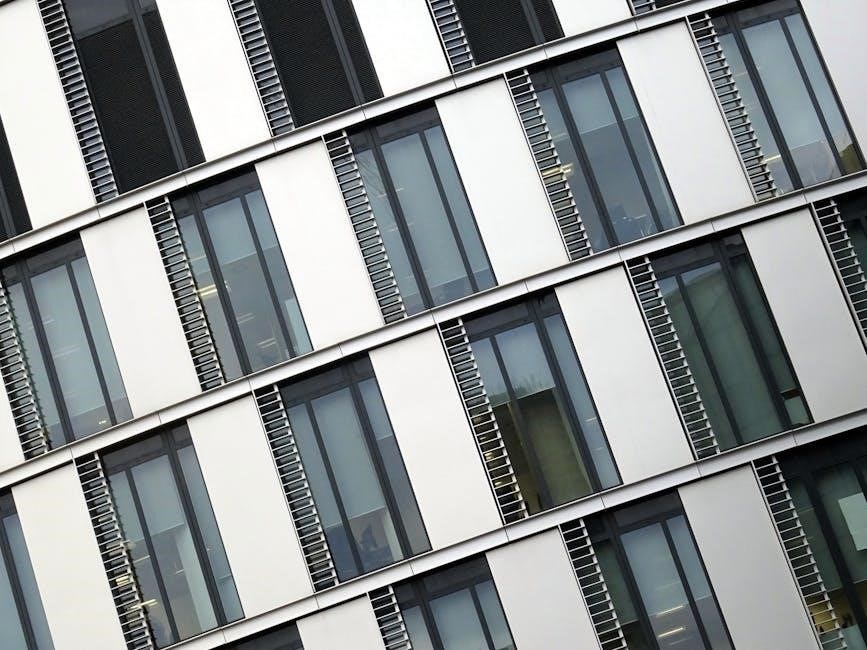Aluminium 6061-T6 is a high-strength‚ lightweight alloy with excellent mechanical properties‚ widely used in aerospace‚ automotive‚ and marine applications due to its versatility and corrosion resistance.
Overview of Aluminium 6061-T6 Alloy
Aluminium 6061-T6 is a medium-to-high strength‚ heat-treatable alloy widely used for its excellent corrosion resistance‚ weldability‚ and medium fatigue strength. It contains magnesium and silicon as primary alloying elements‚ providing a balance of strength‚ toughness‚ and workability. The T6 temper indicates solution heat treatment followed by artificial aging‚ achieving peak mechanical properties. This alloy is highly versatile‚ suitable for structural applications in aerospace‚ automotive‚ and marine industries‚ offering a combination of durability‚ lightweight‚ and resistance to environmental factors‚ making it a popular choice for demanding engineering projects.

Chemical Composition of Aluminium 6061-T6
Aluminium 6061-T6 primarily contains magnesium (0.8-1.2%) and silicon (0.4-0.8%)‚ with minor elements like copper (0.15-0.4%)‚ chromium (0.15-0.35%)‚ and aluminum as the remainder.
Key Alloying Elements
The primary alloying elements in Aluminium 6061-T6 are magnesium (0.8-1.2%) and silicon (0.4-0.8%)‚ which enhance strength and corrosion resistance. Copper (0.15-0.4%) improves conductivity‚ while chromium (0.15-0.35%) refines grain structure. These elements contribute to the alloy’s durability‚ weldability‚ and mechanical performance‚ making it a versatile choice for structural applications.
Chemical Composition Limits
The chemical composition of Aluminium 6061-T6 is strictly defined to ensure consistent properties. Magnesium ranges from 0.8% to 1.2%‚ while silicon ranges from 0.4% to 0.8%. Copper is limited to 0.15%-0.4%‚ and iron to 0;0%-0.7%. Manganese is restricted to 0.0%-0.15%‚ with chromium at 0.0%-0.35%. Zinc and titanium are also present in smaller amounts. These limits ensure the alloy’s strength‚ corrosion resistance‚ and weldability‚ making it suitable for diverse engineering applications.

Physical Properties of Aluminium 6061-T6
Aluminium 6061-T6 exhibits a density of 2.70 g/cc‚ high thermal conductivity‚ and good electrical conductivity. It also demonstrates moderate thermal expansion‚ making it suitable for various engineering applications.
Density
Aluminium 6061-T6 has a density of approximately 2.70 g/cm³ (0.0975 lb/in³)‚ making it a lightweight material compared to steel. This property allows for significant weight reduction in structural applications while maintaining sufficient strength. The density remains relatively consistent across different temper designations‚ ensuring predictable behavior in engineering designs. Its low density‚ combined with good corrosion resistance‚ makes it an ideal choice for aerospace‚ automotive‚ and marine applications where weight optimization is critical. This characteristic also contributes to energy efficiency in transportation and machinery.

Thermal Conductivity
Aluminium 6061-T6 exhibits a thermal conductivity of approximately 173 W/m-K‚ making it suitable for applications requiring efficient heat dissipation. This property allows the alloy to transfer heat effectively‚ which is beneficial in heat exchangers‚ electronic components‚ and automotive parts. Compared to pure aluminum‚ the addition of alloying elements slightly reduces thermal conductivity but enhances mechanical strength. Its relatively high thermal conductivity‚ combined with good corrosion resistance‚ makes it a versatile material for various engineering applications‚ including aerospace and marine industries where thermal management is critical.
Electrical Conductivity
Aluminium 6061-T6 exhibits a relatively high electrical conductivity of approximately 40% IACS (International Annealed Copper Standard). This makes it suitable for applications requiring efficient electrical current flow‚ such as electrical connectors‚ wiring‚ and electronic components. While not as conductive as pure aluminum due to its alloying elements (e.g.‚ magnesium and silicon)‚ its conductivity remains sufficient for many industrial and commercial uses. This balance of conductivity and strength makes it a preferred choice for lightweight‚ high-performance electrical systems in aerospace and automotive industries.
Thermal Expansion
Aluminium 6061-T6 exhibits a coefficient of thermal expansion of approximately 23.4 µm/m·°C (13.0 µin/in·°F). This property is critical for applications where materials are exposed to temperature fluctuations. While higher than some other aluminum alloys‚ its thermal expansion is manageable and predictable‚ making it suitable for aerospace‚ automotive‚ and structural applications. The material’s stability under thermal stress ensures minimal dimensional changes‚ preserving its integrity in diverse environmental conditions. This balance of thermal expansion and mechanical strength contributes to its widespread use in demanding industries.

Mechanical Properties of Aluminium 6061-T6
Aluminium 6061-T6 offers excellent mechanical properties‚ including high tensile strength‚ yield strength‚ and good fatigue resistance‚ making it suitable for demanding applications in aerospace and automotive industries.
Tensile Strength
Aluminium 6061-T6 exhibits a tensile strength of approximately 310 MPa (45‚000 psi)‚ making it a robust choice for structural applications. This strength is achieved after the T6 heat treatment‚ which involves solution heat-treatment followed by artificial aging. The alloy’s tensile strength is complemented by its yield strength of around 270 MPa (39‚000 psi) and an elongation at break of 12%‚ ensuring a balance of strength and ductility. These properties make it highly suitable for aerospace and automotive applications where high performance is critical.
Yield Strength
Aluminium 6061-T6 demonstrates a yield strength of approximately 270 MPa (39‚000 psi)‚ showcasing its ability to withstand significant stress without permanent deformation. This property is crucial for maintaining structural integrity in demanding applications. The T6 temper enhances yield strength through a controlled heat-treatment process‚ making it suitable for high-performance uses in aerospace and automotive industries. Its balance of strength and ductility ensures reliability under various loading conditions‚ making it a preferred choice for critical components requiring durability and stability.
Shear Strength
Aluminium 6061-T6 exhibits a shear strength of approximately 190 MPa (27‚500 psi)‚ making it suitable for applications where high shear loading is anticipated. This property is critical in components subjected to sliding or twisting forces‚ such as bolts‚ gears‚ and shafts. The alloy’s ability to maintain structural integrity under shear stress is enhanced by its T6 temper‚ which optimizes its mechanical properties for durability and reliability. This makes it a preferred material for aerospace‚ automotive‚ and marine hardware requiring high strength-to-weight ratios and resistance to deformation.
Elongation at Break
Aluminium 6061-T6 demonstrates an elongation at break of approximately 12% (measured over a 50mm gauge length)‚ indicating moderate ductility. This property reflects the material’s ability to undergo plastic deformation before fracture‚ which is essential for applications requiring formability. While the T6 temper enhances strength‚ it slightly reduces ductility compared to other tempers‚ making it suitable for structural components where a balance of strength and flexibility is critical. This moderate elongation ensures the alloy can absorb stress without brittle failure in various engineering applications.
Hardness
Aluminium 6061-T6 exhibits a Brinell hardness of approximately 95 HB‚ indicating its resistance to wear and abrasion. This hardness is achieved through the T6 tempering process‚ which involves solution heat treatment followed by artificial aging. The material also demonstrates a Rockwell hardness of around 55 HRB and 15 HRE‚ further highlighting its durability. While the alloy is relatively hard‚ it maintains good machinability‚ making it suitable for applications requiring both strength and precision engineering. This balance of hardness and workability is a key factor in its widespread use across various industries.
Fatigue Strength
Aluminium 6061-T6 demonstrates a fatigue strength of approximately 100 MPa at 500 million cycles under axial loading conditions. This property is critical for applications subjected to cyclic stress‚ such as aircraft components and automotive parts. The T6 temper enhances its resistance to fatigue failure by refining the grain structure and distributing precipitates uniformly. While not as high as alloys like 7075-T6‚ its fatigue strength is sufficient for many structural and mechanical applications‚ making it a reliable choice for industries requiring durability under repeated loading conditions.
Applications of Aluminium 6061-T6
Aluminium 6061-T6 is widely used in aerospace‚ automotive‚ marine‚ and consumer products due to its high strength‚ corrosion resistance‚ and weldability‚ making it ideal for aircraft parts‚ bike frames‚ and marine hardware.
Aerospace Applications
Aluminium 6061-T6 is extensively used in aerospace due to its high strength-to-weight ratio‚ corrosion resistance‚ and weldability. It is commonly employed in aircraft fittings‚ structural components‚ and hardware. The alloy’s ability to maintain its mechanical properties under extreme conditions makes it ideal for aerospace applications. It is also used in camera lens mounts and other precision components. Additionally‚ its resistance to fatigue and stress corrosion cracking ensures reliability in critical aerospace environments‚ including satellites and military equipment‚ where performance and durability are paramount.
Automotive Applications
Aluminium 6061-T6 is widely used in the automotive industry due to its high strength‚ lightweight‚ and excellent corrosion resistance. It is commonly employed in vehicle parts such as engine components‚ drive shafts‚ and suspension systems. The alloy’s weldability and durability make it ideal for manufacturing fuel-efficient vehicles. Additionally‚ its resistance to fatigue and stress corrosion cracking ensures long-term reliability in demanding automotive environments. This alloy is also popular in the production of high-performance bicycle frames‚ further showcasing its versatility in transportation applications.
Marine Applications
Aluminium 6061-T6 is highly valued in marine applications due to its exceptional corrosion resistance‚ even in seawater environments. Its lightweight and high strength make it ideal for marine fittings‚ hardware‚ and structural components. The alloy’s ability to withstand harsh marine conditions without degradation ensures durability and reliability. It is commonly used in boat hulls‚ marine hardware‚ and other saltwater-exposed applications‚ where its resistance to stress corrosion cracking and fatigue is particularly beneficial. This makes it a preferred choice for marine engineering and construction.
Consumer Products
Aluminium 6061-T6 is widely used in consumer products due to its lightweight‚ corrosion-resistant‚ and durable properties. It is a popular choice for bicycle frames‚ camera lens mounts‚ and other portable equipment. The alloy’s high strength-to-weight ratio and excellent corrosion resistance make it ideal for outdoor and recreational products. Additionally‚ its ability to be easily machined and finished ensures a high-quality appearance‚ making it suitable for decorative hardware and consumer goods. Its versatility and cost-effectiveness contribute to its widespread use in everyday applications.

Fabrication and Machining
Aluminium 6061-T6 is known for its excellent fabrication and machining capabilities. It can be easily shaped and processed‚ making it ideal for manufacturing durable and precise components.
Machinability
Aluminium 6061-T6 exhibits excellent machinability‚ making it highly suitable for applications requiring precise and intricate components. It is rated as “excellent” for machining due to its ability to be easily shaped and processed. The alloy can be effectively machined using standard tools‚ but sharp tooling is recommended to achieve optimal results. It maintains good dimensional stability during machining and produces a smooth surface finish. These characteristics make it ideal for applications where tight tolerances and high-quality finishes are required. Its adaptability to various machining processes further enhances its value in production environments.
Weldability
Aluminium 6061-T6 exhibits good weldability‚ particularly through MIG and TIG welding processes. While the alloy can be welded successfully‚ the heat-affected zone may experience a reduction in mechanical properties. Post-weld heat treatment can restore some of the original strength and durability. Proper techniques and filler materials are essential to ensure high-quality welds. The alloy’s weldability makes it suitable for structural and mechanical applications‚ though careful consideration of the welding process is necessary to maintain its performance characteristics. This balance of weldability and strength contributes to its versatility in manufacturing.

Heat Treatment and Temper Designations
Aluminium 6061-T6 undergoes solution heat treatment‚ quenching‚ and artificial aging‚ achieving optimal strength and stability. Temper designations define its mechanical properties‚ with T6 being the most common condition.
T6 Temper
The T6 temper of Aluminium 6061 involves solution heat treatment‚ quenching‚ and artificial aging‚ resulting in maximum strength and stability. This process enhances yield strength‚ tensile strength‚ and hardness while maintaining good ductility. The T6 condition is ideal for applications requiring high mechanical properties and resistance to stress corrosion cracking. It is widely used in aerospace‚ automotive‚ and marine industries due to its excellent balance of strength‚ toughness‚ and corrosion resistance‚ making it a versatile choice for complex engineering applications.
Other Temper Designations
Aluminium 6061 is available in various tempers‚ each offering distinct properties. The T4 temper is solution heat-treated and naturally aged‚ providing good formability. T42 is solution heat-treated and artificially aged‚ offering moderate strength. T8 and T9 tempers enhance chipping characteristics‚ beneficial for machining. The T651 temper is similar to T6 but with stress-relieved properties‚ ideal for plate applications. Each designation caters to specific requirements‚ ensuring versatility across different industries.

Environmental Resistance
Aluminium 6061-T6 exhibits excellent corrosion resistance in atmospheric and seawater conditions‚ making it suitable for marine and outdoor applications due to its naturally forming protective oxide layer.
Corrosion Resistance
Aluminium 6061-T6 exhibits excellent corrosion resistance due to its naturally forming protective oxide layer‚ which prevents degradation in atmospheric and seawater environments. Its magnesium and silicon alloying elements enhance this property‚ making it highly resistant to general corrosion. However‚ in harsher corrosive environments‚ such as those involving chlorides or acids‚ additional protective coatings may be necessary. This alloy is widely used in marine and outdoor applications‚ where its ability to withstand environmental stress is a critical advantage. Its corrosion resistance is a key factor in its popularity for structural and marine applications.
Stress Corrosion Cracking Resistance
Aluminium 6061-T6 demonstrates good resistance to stress corrosion cracking (SCC)‚ particularly in temper T6‚ due to its balanced alloy composition. The presence of magnesium and silicon helps mitigate SCC risks in most environments. However‚ in highly aggressive conditions‚ such as extreme humidity or exposure to chlorides‚ susceptibility may increase. Proper design and surface treatments can further enhance its resistance. This property makes 6061-T6 suitable for structural applications in marine and aerospace industries‚ where environmental and mechanical stresses are significant.

Comparison with Other Aluminium Alloys
Aluminium 6061-T6 offers a balanced combination of strength‚ corrosion resistance‚ and weldability‚ making it more versatile than 6063-T6 but less strong than 7075-T6 in certain applications.
6061-T6 vs. 6063-T6
Aluminium 6061-T6 exhibits higher tensile strength and better mechanical properties compared to 6063-T6‚ making it suitable for structural applications. While 6063-T6 offers superior corrosion resistance and a smoother surface finish‚ it lacks the strength and durability of 6061-T6. Both alloys are weldable‚ but 6061-T6 is preferred for high-stress environments‚ such as aerospace and automotive‚ whereas 6063-T6 is often used in architectural and decorative applications due to its excellent finish and corrosion resistance.
6061-T6 vs. 7075-T6
Aluminium 6061-T6 offers excellent corrosion resistance and weldability‚ making it ideal for marine and automotive applications‚ while 7075-T6 provides higher strength and toughness‚ suited for aerospace and high-stress environments. Although 7075-T6 has superior mechanical properties‚ it lacks the weldability and corrosion resistance of 6061-T6. Both alloys are heat-treatable‚ but 7075-T6 is less resistant to stress corrosion cracking. The choice between them depends on the specific requirements for strength‚ durability‚ and environmental exposure.
Safety and Handling
Handling Aluminium 6061-T6 requires protective gear‚ proper ventilation‚ and safe disposal to minimize risks. Store in dry conditions to prevent corrosion and ensure material integrity.
Precautions in Handling
When handling Aluminium 6061-T6‚ wear protective gear‚ including gloves and goggles‚ to avoid skin and eye irritation. Ensure proper ventilation to prevent inhalation of dust or fumes during machining. Avoid exposure to extreme temperatures or sparks‚ as the material can be sensitive to thermal stress. Store the alloy in a dry‚ clean environment to prevent corrosion. Follow safety guidelines for cutting and welding to maintain material integrity and prevent accidents. Proper disposal methods should be adhered to‚ ensuring environmental safety. Always refer to material safety data sheets for detailed handling instructions.
Recycling and Sustainability
Aluminium 6061-T6 is highly recyclable‚ significantly contributing to sustainability efforts. With a high recycling rate‚ it reduces the demand for primary production and conserves resources. Recycling this alloy saves approximately 95% of the energy needed to produce new aluminium‚ thereby lowering carbon emissions. Industries benefit economically as recycled 6061-T6 retains much of its value. Proper recycling techniques maintain its mechanical properties‚ allowing reuse in applications like aerospace and automotive without performance loss. This supports a circular economy‚ minimizing environmental impact and promoting eco-friendly practices.

Cost Considerations
Aluminium 6061-T6 offers a moderate material and production cost‚ making it a cost-effective option for high-performance applications while balancing strength‚ durability‚ and affordability.
Material Cost
Aluminium 6061-T6 has a moderate material cost compared to other high-strength aluminum alloys. It is generally more expensive than non-heat-treatable alloys but cheaper than premium alloys like 7075-T6. The cost is influenced by the alloying elements‚ particularly magnesium and silicon‚ which enhance its mechanical properties. Its widespread use and large-scale production contribute to economies of scale‚ making it a cost-effective choice for many industrial applications. This balance of performance and affordability makes it a popular option for manufacturers seeking reliable‚ high-strength materials.
Production Cost
The production cost of Aluminium 6061-T6 is influenced by its heat treatment process‚ which includes solution heat treatment‚ quenching‚ and artificial aging. These steps enhance its mechanical properties but add to manufacturing expenses. The alloy’s popularity and large-scale production help optimize costs‚ making it more economical than specialized alloys. Machining and fabrication costs are moderate due to its good machinability and weldability. Overall‚ the production cost is balanced‚ offering a cost-effective solution for high-performance applications while maintaining quality and reliability.
Aluminium 6061-T6 is a versatile and widely used alloy‚ offering an excellent balance of strength‚ corrosion resistance‚ and weldability. Its heat-treated properties make it suitable for demanding applications in aerospace‚ automotive‚ and marine industries. With its moderate production costs and high performance‚ it remains a popular choice for engineers seeking reliable and durable materials. The alloy’s adaptability ensures its continued relevance in modern manufacturing‚ making it a cornerstone for various structural and mechanical applications.
